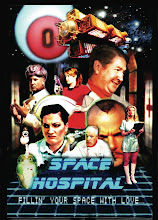 |
| Nurse Barbara (Anne Ford Galiana) ready to kick butt - Love American Style. |
Yesterday, we released episode 8.0, “The Buckfire Chronicles,” which you can watch on YouTube or in Koldcast’s high definition player.
Previously on Space Hospital, Nurse Barbara laid an enormous egg. She worries her offspring might be a murderous lizard/human hybrid like his father, but Omacron reveals that Nurse Ratknee is the one carrying a dracomorph (not the first time she’s been an incubator for something not entirely human). Sister Hilly charms her way aboard Space Hospital and steals the egg, believing it contains the dracomorph queen. Meanwhile, Yeoman Long ponders the microchip found in zombie Snead as strange half-memories of her death and resurrection bubble up.
 |
| Babs with dashing and punctual Joe Buckfire (Blaine Vedros) |
THE SCIENCE:
Enormous distances, long travel times (it takes over a year to get to Mars and back, and that's our closest neighbor) and the ability to carry adequate fuel supplies are some of the biggest obstacles standing between humans and deep space travel. Science fiction’s ubiquitous solution is hyperdrive – a means of traveling to faraway places rapidly, usually to elude bad guys.
Though common in sci-fi, hyperdrive theories hover on the fringe of the scientific mainstream. From 1996 to 2002, however, NASA provided funding to the Breakthrough Propulsion Physics Program to support "exotic" propulsion theories not supported in university research or the private sector. And in 2005, the American Institute of Aeronautics & Astronautics gave Jochem Häuser and Walter Dröscher an award for their paper, “"Guidelines For a Space Propulsion Device Based on Heim's Quantum Theory.” They proposed a practical means to test the theories of German scientist Burkhard Heim who, in the 1950s, proposed a new form of propulsion that expanded Einstein’s four dimensions into six, which theoretically allowed for the conversion of electromagnetic energy into gravitational energy (and vice versa). Häuser and Dröscher suggested that current pumped through superconducting coil around a spaceship would create a “repulsive anti-gravity” force capable of propelling the ship faster than light.
How many years away are we from hyperdrives and deep space travel? Well, here in Calfornia, we're still trying to figure out if we can afford to invest in high-speed rail between Los Angeles and San Francisco (a project now expected to take about 20 years and $100 billion dollars to complete). At these prices and in this global economy, getting between here and the stars is going to remain the stuff of fiction for some time.
How many years away are we from hyperdrives and deep space travel? Well, here in Calfornia, we're still trying to figure out if we can afford to invest in high-speed rail between Los Angeles and San Francisco (a project now expected to take about 20 years and $100 billion dollars to complete). At these prices and in this global economy, getting between here and the stars is going to remain the stuff of fiction for some time.
 |
| "So long, suckers! We've got an egg to save!" |






